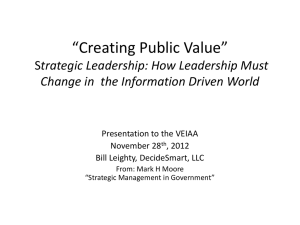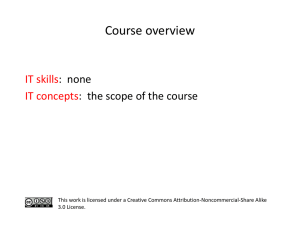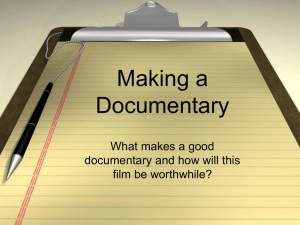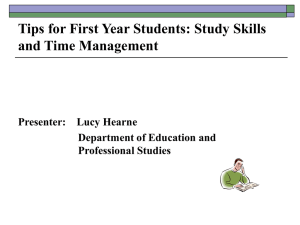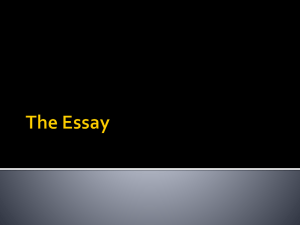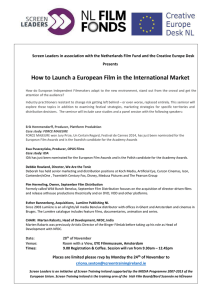Bowling For Columbine
advertisement
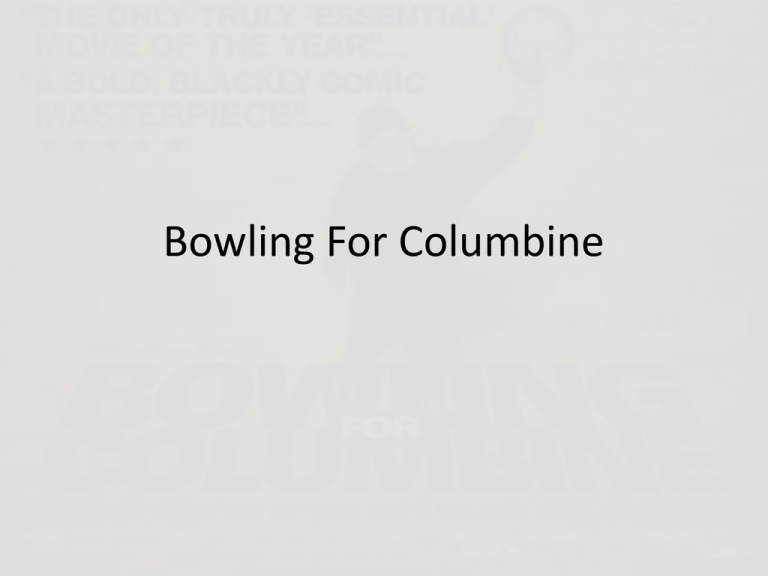
Bowling For Columbine BFC Notes • Oscar winning – Best Documentary feature 2003. • First documentary to be accepted into Cannes Film Festival in 46 years. • Received high critical acclaim. • Broken all box-office records to date for a documentary film in the UK. Genre - Documentary? • • • • Facts Comic relief Biased if persuasive Emotive • • • • • • • Interview Facts Low-budget Objective Boring Narrator Different sources of media, • Educational • Real? Categories • Now that we have viewed BFC, try to write a paragraph for homework on Categories for Wednesday. • What should you discuss when writing about categories? • How would you define BFC? What genre would you say it fits into? • • • • • • • • BBC Review Funny, chilling and provocative, "Bowling for Columbine" is a documentary that works as a hugely entertaining movie, as well as a double-barreled blast at American gun culture and the media. It starts with tubby, bear-faced American satirist Michael Moore opening a bank account and receiving a rifle as a free gift. Unbelievable, but not the only shocking element in this powerful exploration of violence in the USA. Moore's inquiries into why America is such a violent society are sparked by the Columbine massacre - the 1999 high school shooting in which 13 people were killed by two malcontent teens who then took their own lives. At first, it seems his answer will be obvious: readily available guns. But what appears to be a simplistic anti-gun polemic broadens in scope, to tar the media, racism, greed and US foreign policy. Could it be, he argues, that the public is affected by a violent, interventionist state and the "if it bleeds, it leads" attitude of the news media, rather than video games and rock music? Moore's left-wing bias is obvious, but "Bowling for Columbine" is no exercise in pious liberal handwringing. The director/star is a plain-speaking, sharp-witted everyman, who isn't looking to score cheap political points, but is infused with a spirit of honest inquiry. He's been accused of manipulation, but filmmaking is manipulation. And there's no twisting the words of Charlton Heston, when the head of the hugely influential National Rifle Association limply ascribes the murder rate to "mixed ethnicity" and America's "history of violence". This is a bold, blackly comic masterpiece - everyone should see it. Reviewed by Nev Pierce Updated 13 November 2002 Documentary Definition?… • The connotation of the word documentary is of something factual and objective. • The simplest definition of documentary film is that it is non-fiction film-making; that it documents reality/truth in a straight forward way. Of course, a deeper look at documentary complicates any such simple definition. Bowling For Columbine – Documentary? • No… • Yes… Uses facts (statistics) Deals with a ‘real’ issue. Uses archived evidence (CCTV, emergency calls, news reports…) • Statistics appropriate to context? • Aspects of mockumentary genre (South Park) • Apparent bias – subjective • Questioning technique to elicit response he wants/direct conversation. • Emotively charged. • Clever editing creates air of subjectivity in contrast to observational style. • Moore himself is intrusive part of the documentary. Difficulty • In a famous phrase Grierson (The Scottish filmmaker John Grierson) defined documentary as the ‘creative treatment of actuality’. • While documentaries deal with different areas of ‘actuality’ or ‘real life’, their ‘creative treatment’ of the subject matter has varied enormously. Reality TV documentary? What of the following are documentaries: Morgan Spurlock’s Fast Food Nation Panorama The Only Way is Essex Frozen Planet Bowling For Columbine – Documentary? • What is the problem with calling BFC a documentary? • Brainstorm these ideas in your group. Bowling For Columbine Documentary? • It is not an observational, balanced, objective view of the subject matter. Why? • Moore appears in the film. • He uses interspersing interviews with an inspired and considered selection of persons, each of whom is likely to make a considerable impact on the viewer, • He depicts of various dramatic and emotive situations and then suffuses nearly every scene of his movie with an incisive wittiness. Documentary Form • Documentary films have messages that they want their audience to accept as truth. • Filmmakers edit and shape their works to persuade an audience or make them intentionally feel certain ways. • Documentarians are contructors of realities, and not simply documentors of reality. • Filmmakers try to position audiences and shape such realities for them. Codes and Conventions of the Genre • Semantics: a set of features that connote ‘realism’ (the documentary ‘look’) • What do you think these are? Answer • Archive clips from TV and film • ‘Talking heads’ on TV • Jiggly hand held camera when interviews in Canada and USA • Location shooting and sound • Voiceover narration by Michael Moore • Real people rather than actors • Documentary editing which makes an argument (cf. continuity editing of fiction) Michael Moore as ‘auteur’: • (Bowling for Columbine carries Moore’s authorial stamp. • He wrote, directed, produced and stars in the film. • He even narrates the film) Auteur • • • • • • • • • • • • MM an ensemble of signs which connotes ‘ordinary guy’ Narcissist, self publicist and entrepreneur Inserts himself into public debates Staged encounters with authority – MM has a series of TV shows and films which show that ‘big shots’ do what they want and don’t care about ‘ordinary folks’ Speculations give enough information to cause suspicion but not enough to make a case Distorts facts First person polemic with punch lines Excludes articulate opponents of his arguments Mixes comedy and tragedy Comic/ironic use of music Funny, opinionated, sometimes eloquent Exhaustive research. Expert editing and structuring of material with montages of archive material. Purpose • What do you think Moore’s purpose was in creating the film? • Clearly to educate, is his main motivation but if this is the case, what educational question/ message is he exploring? • "Bowling for Columbine is about something much larger an entire society gone slightly mad and arming itself at home with a quarter billion guns.“ (Moore) • Are there other purposes to the film? • To entertain? • "The one thing you have to realize about Michael," says producer Michael Donovan, "is that he's the ultimate patriot. That's why he's so critical. He loves his country. It's ironic that one of America's leading social critics is also one of its leading patriots." • Bowling For Columbine was written, produced and directed by the American satirist and filmmaker Michael Moore following on the events of April 20th 1999, when two students at Columbine High School in Littleton, Colorado, went on a killing spree, shooting to death twelve of their classmates and a teacher and injuring many others before killing themselves. • This feature-length documentary, which has received numerous awards: • the Oscar for Best Documentary Feature and the Special Jury Prize at the Cannes Film Festival in 2003, is a wideranging and provocative investigation into the possible causes of such tragedies. • ‘Are we a nation of gun nuts or are we just nuts?’ • Michael Moore Michael Moore • Stubble, overweight, cap, sweatshirt – average Joe that we can relate with. • Sarcastic • Dead-pan delving of questions • Very Biased Narrative – Codes and Conventions of Documentary (Interactive/reflective) • Voiceover, addresses the audience directly. • Voiceover may be a ‘Voice of God’ commentator (heard but not seen) or a voice of authority (seen and heard) commentary, usually a expert in the relevant field. • Images used to illustrate (or sometimes counterpoint) the voiceover. • Assembles a variety of footage; interviews, stills, archive material to support the argument. • Attempts to persuade the audience of a particular point of view, often by appealing to logic and the idea of common sense. • Location shooting (hand-held camera) • Synchronous (direct) sound recording. • Documentary maker is visible to the audience – intervenes and participates in the action. Narrative • • • • All over the place. Switches from one idea to the other a lot. Audience reaction – where is this going? Interwoven storylines are eventually tied together in some sense by Moore at the end. Montage of Massacre • Use of ‘real’ 911 phone calls. • Hear as you go through empty school – powerful and haunting experience. • CCTV footage • Guitar climb over the top. • Aftermath news footage. Powerful use of music and capitalism facts • Montage – “What a Wonderful World” Contrapuntal sound Thinking about Audience… • What influences the audience’s viewpoint and add towards the overall message of the film. • Techniques used by Moore such as: • The use of editing, • Sound • Inclusion of comedy satire Task 15/11/12 – Decoding Meaning You will be issued with a transcript of a scene from the film. You should use your knowledge of media to identify/analyse: • • • • • The way in which Moore has constructed that scene for a specific reason. What technical and cultural codes/ stereotypes etc are evident that help us to decode Moore’s meaning? What you think he is trying to say through his careful construction/ editing of the scene. The effect/impact this scene has on audience. What reading(s) the audience might take from this scene. What type of documentary styles are used. Class example… • CHAPTER 1. MORNING IN AMERICA 1. First image is from a film promoting the National Rifle Association. (this is in black and white) A man dressed in an Army uniform—full dress—says, “The National Rifle Association has produced a film which you are sure to find of great interest. Let’s look at it. Then Michael Moore voice-over, against images of people at work in America. It sounds like a typical “morning in America” spiel, but one of the images shows bombed out buildings as Michael Moore says, “and the President ordered the bombing of another country we couldn’t pronounce,” and then he refers to “the little town in Colorado two boys went bowling at six in the morning.” Cut to the bowling and then to a cute “chick” in a bikini—as she holds up an M-16. Dissolve to the Statue of Liberty. Moore’s voice-over: It was a typical day in the United States of America. Glamorized Manson • 21. Cut to shots of little kids, who in voice-over Michael Moore characterizes as having turned “into little monsters.” His voice-over: But who was to blame? Another montage: of various “experts”—each of whom has the answer: the heavy-metal subculture, parents, violent movies, South Park cartoons, video games, television, entertainment, Satan, cartoons, society, toy guns, drugs, shock rocker Marilyn Manson—and then six times “Marilyn Manson.” • 22) Cut to a news report of Manson canceling the last five days of his national tour out of respect for the families of the Columbine students. “The singer says that artists like himself are not the ones to blame.” Senator Joe Lieberman on tape: “This is the sickest group ever promoted by a mainstream record company.” Shots of Marilyn Manson performing—shocking! Moore’s voiceover: The killers listened to Marilyn Manson. Two years later, Manson comes back to Denver. Reports of protest. “I thought I’d go and talk with him myself.” Quick shot of Moore, dressed in his trademark floppy shirt, blue jeans, tennis shoes, and baseball cap, walking behind the arena. Manson on camera in his dressing room. “When I was growing up, music was the escape. That was the only thing that had no judgments. You put on a record, it’s not going to yell at you for dressing the way you do. It’s going to make you feel better about it.” Cut to a protester (Christian conservative, I presume), who speaks to a protest crowd. Will people who listen to Manson go out and commit violent acts? No! “But does everybody who watches a Lexus ad go out and buy a Lexus? No! But a few do!” Back to Manson. He admits that he is “the poster boy for fear. I represent what everyone’s afraid of. I do and say what I want. Back to the protest speaker. Then Manson again: “The two by-products of that whole tragedy were violence in entertainment and gun control—and how perfect that those were the two things we were going to talk about in the upcoming election. And then we forgot about Monica Lewinsky, and the President was shooting bombs overseas, yet I’m a bad guy because I sang some rock and roll songs. Who was the bigger influence? The President or Marilyn Manson? Here Michael Moore interjects that the same day as Columbine the U.S. (really NATO) dropped more bombs on Kosovo than anytime in the war? Wide shot of the tiny room—Michael Moore sitting across from Manson. That latter says, “You’re being pumped full of fear. There’s floods, there’s AIDS, buy the Acura, cut to commercial, if you’ve got pimples—nobody’s going to fuck you. It’s a campaign of fear and consumption. Keep everyone afraid, and they’ll consume.” Michael Moore asks, “What would you say to the kids of Columbine.” Manson answers, “I wouldn’t say a single thing. I would listen to what they have to say. And that’s what no one did.” CHAPTER 17: A BRIEF HISTORY OF AMERICA • 26. Cut to the South Park cartoon’s “A Brief History of the United States of America.” The narrator of the film is a bullet cartoon character. We see the Pilgrims who were AFRAID of being persecuted. Off they sail to the New World. But then they were scared of the Natives, and they got scared all over again. “So they killed them all.” Next they got afraid of each other. Then they burned witches. Then they killed the British in the Revolutionary War. But they were still afraid. So here comes the 2nd Amendment, and now every white man can keep his gun. A new American says, “I loves my gun!” Here comes slavery. They kidnap Africans and bring them back for slaves. And the slaves got no money for their work, and America became rich. But after 200 years of slavery, the white people became afraid of the black people. But then Samuel Colt in 1836 patents the first six-shooter, and the white people snatched them up. But it was too late—the Civil War was over, and the slaves were free. Now the whites were really afraid. But the slaves took no revenge. Bu there comes the KKK, and in 1871, the same year the Klan became a terrorist organization, another group, the NRA, was founded. Now politicians passed a law that made it illegal for a black man to own a gun. Flash forward to 1955, when Rosa Parks wouldn’t move to the back of the bus. “Then all hell broke loose”-the Civil Rights movement. White people were so afraid they all fled to the suburbs. And then they went out and bought millions of guns, locked themselves behind gates and fences, and felt safe and secure. “And everyone lived happily ever after.” Last shot shows the entire family—baby included—holding up a gun. CHAPTER 25: LITTLE KALYA • 36. Screen fades to black. Now Moore uses graphics on the screen as we listen to the 911 call that came from Buell Elementary School in Flint, Michigan, when a little 6-year-old girl was shot and killed by her classmate. The teacher becomes increasingly despondent as she talks to the dispatcher, and finally she wails, “Please Lord! Please Lord! Please Lord!” Cut to Michael Moore in the hallway of the school talking to the principal, an elegantly-dressed African American woman. She recalls that when the police came in, “You’re no longer in control.” Camera stays on both of them. Then an exterior of the school, as Moore’s voiceover reveals that the school was in Flint, Michigan, his old hometown. The boy found a gun at his uncle’s house, brought it to school, and shot the girl. Cut to a tiny plastic elementary school chair. Moore’s voice-over: With one bullet, that passed through her body, she fell to the floor and laid their dying, while her teacher called 911 for help. No one knew why the little boy wanted to shoot the little girl. Flint was now home to a new record—the youngest school shooting ever in the United States. Cut to the flowers left at the entrance to the school. Cut to the media remote news vans. Moore’s voice-over: On the morning of the shooting, it only took the helicopters and satellite trucks a half hour to show up on the scene. Then Moore shows us several reporters making their remote spots. He focuses on one young male reporter who barks at his producer after taping his spot. “We’re having technical problems—okay?” The camera stays on him as he chats breezily with one of the assistants. Later, we see this same reporter sitting on the edge of the remote van while an editor cuts his spot. He complains that “some networks that unfortunately go from tragedy to tragedy. I feel bad for them, because that’s all they see.” Camera pans right inside the van and shows a small photograph of the little girl taped there. • As Bowling For Columbine opens, footage from the National Rifle Association is shown. It is included to imply that the NRA is endorsing the film, but the fact the footage is in black and white (as opposed to the majority of the film) and is clearly from old film footage, the viewer is prevented from taking this viewpoint and this inclusion is therefore seen as another form of irony or social satire along with the other pieces of archive footage included in the film. • After a short sequence showing scenes of devastation from bombings and glamorous images of people posing with guns interspersed with everyday events such as children arriving at school and farmers doing their daily chores, the film goes straight into the narrative with little introduction, showing Moore going into a bank and receiving a complimentary firearm. Moore appears in all of his documentaries as a separate character, if you will and Louise Spence states, “It is this constructed, ‘enacted,’ self that secures the bond with the referential world and lends a particular voice to the documentary.”[2] The inclusion of Moore in the documentary is critical to the atmosphere of the film and his ordinary, jokey, seemingly working class persona gives the masses a character within the narrative to relate to and side with. It would be difficult to feel a connection with a disembodied voice such as the Voices Of God from propaganda documentaries of the 1930s and 40s. • This persona is further emphasised by the inclusion of home video footage of Moore as a young boy and his personal background with the rifle subculture and how he was interested from a young age. This segment shows he is not in any position to condemn or judge gun owners, and enables the documentary to maintain some level of objectivity. This use of autobiographical stories is a classic feature of the personal documentary and, in particular, Moore’s films. Stuart Klawans states, “Most of us have this same habit of narrative egomania; when telling about September 11, we begin with what we ate that day for breakfast. In constructing a movie, Moore puts on this trait much as he wears his baseball cap; it’s a sign, meant to establish a rapport with the audience by proving he’s like us.”[3] In other words, this is another technique to ensure the audience connect with his persona and identify with his viewpoint. By knowing about his background and personal information about him, the viewer feels as though he is almost a friend and they can trust him to show the truth about issues. • Moore’s first set of interviews is with the Militia. What is most interesting about this documentary is the fact that Moore is never heard to outwardly condemn or lay down his viewpoint on any of these subject matters, but throughout the film, the use of clever editing is seen to mock and satirise the content. Klawans speaks of this sequence, however, stating, “The point of owning weapons and learning to use them, says a mother, is simply to “take care of your family by yourself.” While she says this, her little girl is toddling about in a playground of loaded weapons. All it would take from Moore would be one quip, or a single mocking camera angle, to turn the mother into a nut-job. But he restrains himself; he gives her every chance to be plausible.”[4] In this case, Moore lets the footage speak for itself. • Another example of this, is the interview with Nichols. He is positioned within his own home, a technique which is used to make the interviewee comfortable and enable him to say how he truly feels. However, this particular interview could also seem to be quite intrusive. The nature of the controversial questions concerning firearms and explosives seems rather heavy and an invasion of the man’s personal environment. Equally, the choice of what footage is included in this interview, make the subject seem manic and unstable. He talks quickly and, often, angrily to Moore and is later is heard (and informed by words on screen) to put a loaded gun to his head. By including these elements, Moore is almost disregarding everything the man has said to be the ramblings of a mad man and something not to be considered in the debate. EDITING • In Bowling for Columbine, quick cuts are often used to transition between scenes. These cuts quickly transition into the next scene or setting. This helps to move the story along quicker at some points than a slow transition would. It is also used strategically for dramatic effect. As a documentary, the film includes a number of interviews. These quick cuts can then be used to highlight sections of these interviews or leave out unwanted parts. Bank • This technique is a legitimate one but is not necessarily fair or honest. It is legitimate to use quick cuts to keep the pace of the story. However, these cuts create the problem of leaving material out of an interview. For example, at the start of the film when Moore buys a gun, he asks someone at the bank if they think it is a good idea to be giving out guns at a bank. Rather than show this person’s answer, the film quickly cuts to a shot of Moore outside the bank. Because the audience is never shown the answer, they are more inclined to side with Moore and assume that the bank did not have a good answer. This technique is used throughout the film to shape the opinion of the audience to match Moore’s. This is unfair because it leaves out parts of interviews that may contain legitimate counter arguments and edits them in favor of the director’s opinion. Charlton Heston Shot • In Bowling for Columbine, Michael Moore uses many different editing techniques in order to sway the viewer’s sympathies towards his own motives. However, not all of the techniques used by Moore can be considered honest. • One specific technique used by Moore in Bowling for Columbine is the over the shoulder shot. This shot is used in the interview that Moore has with Charlton Heston. Heston is the president of the National Rifle Association at the time, and Moore asks him why he went to Flint, Michigan and to Columbine, Colorado to have NRA rallies after the two school shootings that took place there. Heston ends up walking away from the interview, and the camera shows Moore following him. Moore appears to show Heston the picture of the 6 year old girl who was shot by here classmate, and Heston again walks away. The scene then ends with Moore putting the picture outside his home and walking away. • First, Moore shows a quick shot of Heston walking away without Moore’s shoulder in it, and Moore calls out to him. Heston turns around and Moore shows him the picture of the little girl. However, the viewer is never shown a picture of Heston, Moore and the picture of the little girl in the same frame. Moore uses the over the shoulder shot to imply that there is a shot of him showing the picture, but the viewer never sees this. Because they never show Heston talking back to Moore, it would have been very easy for Moore to edit this scene to make the viewer more sympathetic to Moore’s cause. Also, the scene when Moore places the picture in front of Heston’s home does not involve Heston at all. Therefore, the technique used here by Moore is not legitimate, fair and honest because we do not know what kind of editing went into this scene. With clever editing and the over the shoulder shot in Bowling for Columbine, Moore could very well have changed the conversation had by himself and Charlton Heston in order to make the viewer more sympathetic to Moore’s cause. Moore’s use of Cutting in Bowling for Columbine • While Bowling for Columbine is edited mostly through the use of montages and long takes of interviews, Michael Moore also uses quick cuts of people he is interviewing to reveal more about them or to send a message to the viewer. For example, Moore might be interviewing a person, and between shots of the person talking to the camera we see brief clips of the them engaged in other activities. This can be seen when Moore is interviewing a man who was described at the #2 threat to the school due to his possession of the “Anarchist’s Cookbook.” Right after the man says that he has made homemade bombs before, the film quickly cuts to a shot of the man playing a video game, shooting targets with a gun. • This sudden cut implies that the man is violent, and when juxtaposed to the words he is speaking, suggests that he may be dangerous. • This technique of editing short clips into interviews is completely legitimate as far as creating a film goes- if the director is trying to get a point accross or convey a message, this in one effective way to do so. Labeling it fair or honest, on the other hand, is a different situation. In the same way that it is difficult to call a film “realistic”, it is difficult to call a filming technique “honest” or “fair.” In all films, certain things are focused on and other things cut out, creating an automatic bias. This technique in particular takes footage that is out of context and strategically places it in order to convery a message or provoke a feeling from the audience. Pan Shot • • A cinematic technique used in Bowling for Columbine was his usage of a pan shot. This camera motion was used memorably at the end of the documentary, when Charlton Heston was walking away from Michael Moore and into his house. Moore followed Charlton until he went inside his house, away from our view. That’s when the camera ran continually as Moore placed a picture of the shot 6-year old girl on one of Charlton’s house pillars and the camera followed him as he walked away. Documentaries typically use this camera motion a lot because there’s no need to purposefully make a scene dramatic or edited cuts back and forth; everything is important to the message the director is trying to get across, so many parts do not need to be cut. The effect of having the pan at the end was to show Moore’s reaction to Charlton walking away from him and to give a feeling of finality in the documentary by watching him walk away. This is a very honest and legitimate technique because documentaries try to get a message across that requires true facts and interviews with real businessmen, people, and more, whereas other films are about the action or romance or mystery with characters played by actors taking on a role. The pan shot shows everything that happens between the people being interviewed and real length footages of events, such as disasters, which were shown in this documentary. Point of View TASK Watch the opening sequence of Bowling For Columbine up to and including the credits. The film begins with archive footage of an NRA (National Rifle Association) advert followed by shots of Americans going about their normal, everyday business on April 20, 1999. Are there any surprises? Are there uses of humour? How do the voice-over narration and accompanying music anchor the meaning of the pictures? • Why do you think Moore chooses to feature himself so prominently in the Michigan bank scene? What is the effect? • Do you detect a point of view and, if so, what is it? • • Purpose • What are Moore’s different purposes within the film and how are they made clear within the film? In other words, how does he achieve these different purposes? • Try to give clear examples. • What does Moore want the audience to think after viewing ‘Bowling For Columbine’? Educate Entertain Persude Advocate Social Change Inspire New Mindsets Provoke Editing TASK Watch the sequence that begins with the montage of sound bytes condemning Marilyn Manson and finishes at the end of his interview (scene 7 on the DVD). • This sequence begins with the inter-cutting of comments from unnamed politicians and members of the ‘religious right’ with an interview with the singer. • How is each side of the argument presented here? Consider, for example, the editing,role of the voice-over commentary, and the relationship between Moore and Manson. Voiceover Commentary • Voiceover against image of innocent looking children suggests that they have “turned into little monsters BUT who is to blame? Is the key question that Moore then goes on to explore in this sequence. • Narration of long, large list of possible causes; Heavy metal subculture, parents, violent video games/ films, Satan…culminates in repetition of cause being Manson. Lyrics – “I’m not a slave to a God that doesn’t exist” resounding when right-wing religious speaking is blaming Manson. He is the one who is portrayed as aggressive, threatening and unaccepting. Editing • Use of a montage to convey Moore undermining the views/ opinions of mass media and hyped blame culture. • The increasing speed in which the sequence cuts between one image/ interview/ footage etc conveys the increasing hysteria of the American public and their need for a scapegoat to help them rationalise their fears. Relationship – Moore and Manson • Medium shots used to establish the comfortable/ relaxed mood in the room. • Body language – Manson’s foot on Moore’s chair – familiar/ intimate posture reflects that they share common views. • Moore allows Manson to lead the conversation and illustrates his empathy for Manson by affirming nods and lack of intrusive, abrupt questioning such as those used with Heston in the final scenes. • Calm/ collected demeanour allows Manson to be presented as the opposite of those shouting in previous footage, illustrating him as a rounded, intelligent, normal person. Breaks the stereotype and unmasks view of him as “poster boy for fear”. Narrative Some Notes • Uses accumulated 200 hours of material and condenses it into a 2 hour narrative. •
